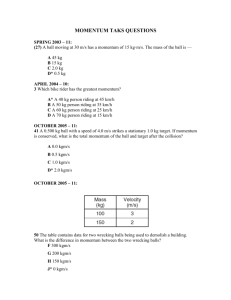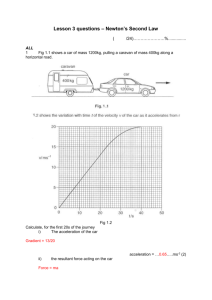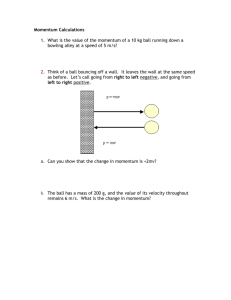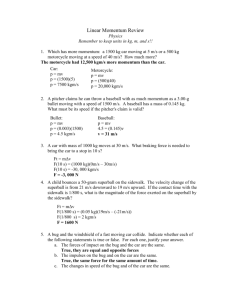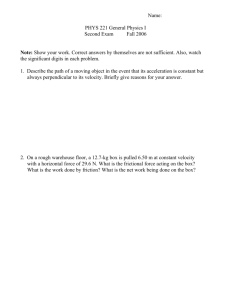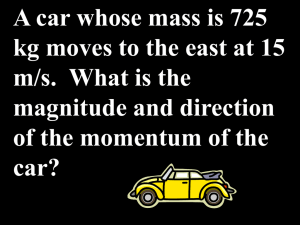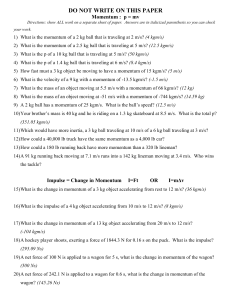Practice Momentum Quiz - Red Hook Central School District
advertisement
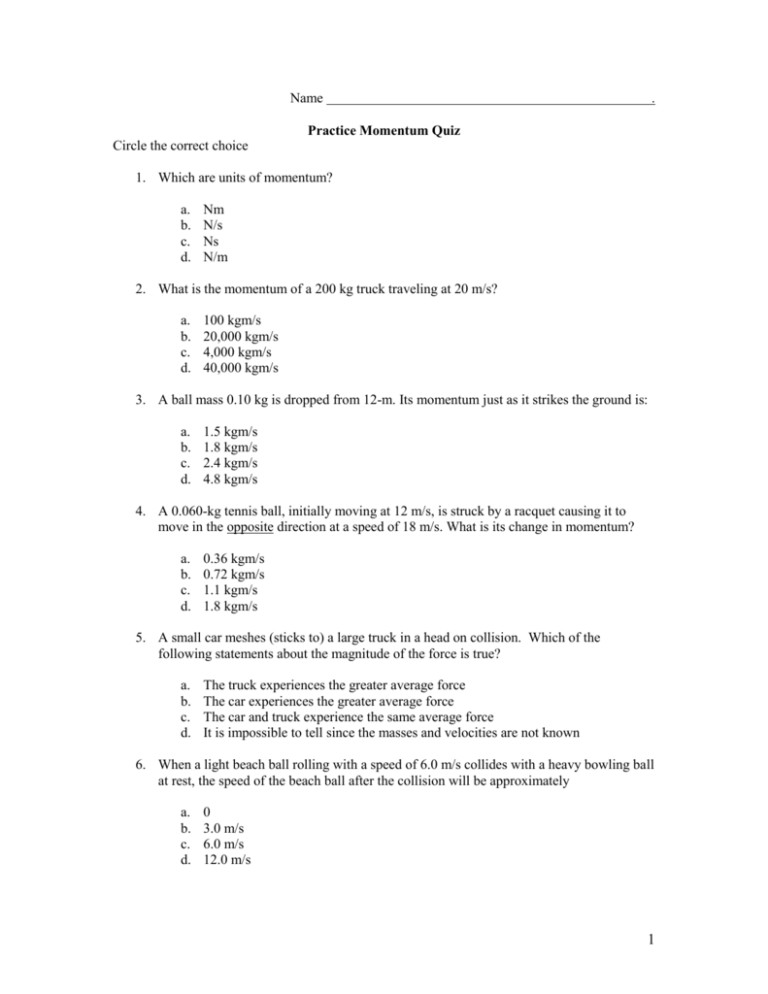
Name . Practice Momentum Quiz Circle the correct choice 1. Which are units of momentum? a. b. c. d. Nm N/s Ns N/m 2. What is the momentum of a 200 kg truck traveling at 20 m/s? a. b. c. d. 100 kgm/s 20,000 kgm/s 4,000 kgm/s 40,000 kgm/s 3. A ball mass 0.10 kg is dropped from 12-m. Its momentum just as it strikes the ground is: a. b. c. d. 1.5 kgm/s 1.8 kgm/s 2.4 kgm/s 4.8 kgm/s 4. A 0.060-kg tennis ball, initially moving at 12 m/s, is struck by a racquet causing it to move in the opposite direction at a speed of 18 m/s. What is its change in momentum? a. b. c. d. 0.36 kgm/s 0.72 kgm/s 1.1 kgm/s 1.8 kgm/s 5. A small car meshes (sticks to) a large truck in a head on collision. Which of the following statements about the magnitude of the force is true? a. b. c. d. The truck experiences the greater average force The car experiences the greater average force The car and truck experience the same average force It is impossible to tell since the masses and velocities are not known 6. When a light beach ball rolling with a speed of 6.0 m/s collides with a heavy bowling ball at rest, the speed of the beach ball after the collision will be approximately a. b. c. d. 0 3.0 m/s 6.0 m/s 12.0 m/s 1 7. A 10 g bullet moving at 300 m/s is fired into a 1.0 kg block. The bullet passes through the block (does not embed itself) and emerges with half its original speed. What is the velocity of the block right after the collision? a. b. c. d. 1.5 m/s 2.97 m/s 3.00 m/s 273 m/s 8. A constant 6.0 N force acts for 4.0 seconds on a 12 kg object. What is the object’s change in velocity? a. b. c. d. 2.0 m/s 12 m/s 18 m/s 288 m/s 9. A 0.1 kg ball is dropped onto a tabletop. The speeds of the ball right before and right after hitting the tabletop are 5 m/s and 4 m/s respectively. If the collision between ball and table lasts for 0.15 seconds, what is the magnitude of the average force exerted on the ball by the table? a. b. c. d. 0.67 N 1.3 N 3.0 N 6.0 N 10. Two equal mass balls (one red and the other blue) are dropped from the same height, and rebound off the floor. The red ball rebounds to a higher position. Which ball is subjected to the greater impulse during its collision with the floor? a. b. c. d. It’s impossible to tell since the time intervals and forces are not known Both balls experienced the same impulse. The blue ball The red ball. 11. A 10-kg object traveling at 6 m/s collides head on with a 2-kg object at rest. What is the total momentum of the system after the collision? 2 12. A hand grenade is on the ground at rest. After a minute it explodes into 150 different sized fragments. After the explosion: a. What is the total momentum of the fragments? b. How does the total KE of the fragments compare with the total KE before the explosion? 3 Name . Show all equations. Show all work with appropriate units. Circle answer. 13. For how much time should a 10 N force be applied to a 5-kg object to cause its velocity to slow from 7.0 m/s to 4.0 m/s? (3) 14. The “human cannonball” has long been a popular – and extremely dangerous- circus stunt. In order for a 45 kg person to leave the cannon with the fastest speed yet attained, a 1.6 x 103 N force must be exerted on that person for 0.68 s. What is the record speed attained? (3) 15. A 0.025 kg bullet is fired from a 9 kg gun with a velocity of 663 m/s. What is the recoil velocity of the gun? (3) 4 16. A 1500 kg car traveling at 30 m/s hits a stationary 1200 kg car. If they lock on collision, what is the final velocity of the two cars? (3) 17. An 11 kg steel ball, traveling left to right at 12 m/s, undergoes a totally elastic collision with a 5 kg steel ball at rest. To the nearest Joule, what is the Total Kinetic Energy of the two balls after collision? (3) 18. A 2000-kg car moving 10 m/s rear ends a 4000 kg truck initially at rest. Their bumpers lock and they wreck moves off together. What is the final momentum of the car-truck wreck? 19. A 1500-kg car rear ends a 4000 kg truck initially at rest. If the bumpers lock and they wreck moves off together at 2 m/s, what was the initial velocity of the car? 20. You are standing on a log and a friend is trying to knock you off. He throws the ball at you. You can catch it, or you can let it bounce off of you. Which is more likely to topple you, catching the ball or letting it bounce off? Why? Explain. 5
